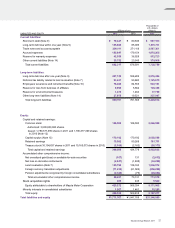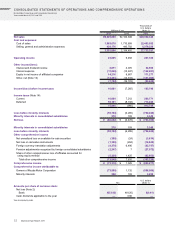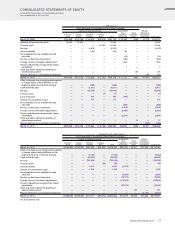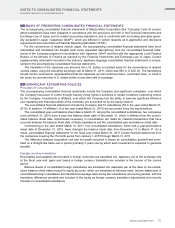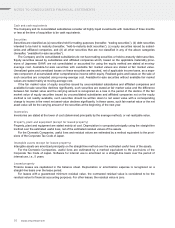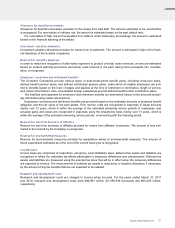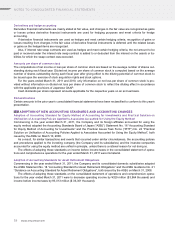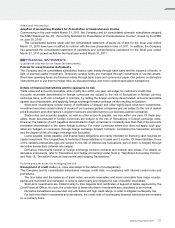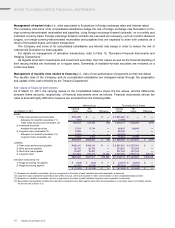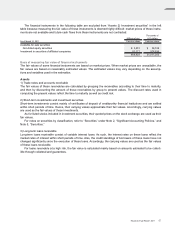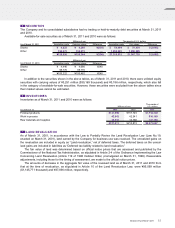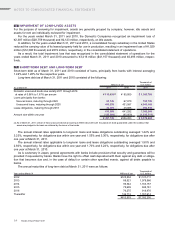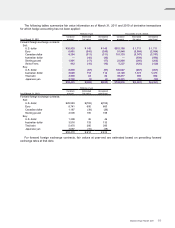Mazda 2011 Annual Report Download - page 61
Download and view the complete annual report
Please find page 61 of the 2011 Mazda annual report below. You can navigate through the pages in the report by either clicking on the pages listed below, or by using the keyword search tool below to find specific information within the annual report.
Additional Information
Adoption of Accounting Standard for Presentation of Comprehensive Income
Commencing in the year ended March 31, 2011, the Company and its consolidated domestic subsidiaries adopted
the ASBJ Statement No. 25, “Accounting Standard for Presentation of Comprehensive Income”, issued by the ASBJ
on June 30, 2010.
The consolidated balance sheet and the consolidated statement of equity as of and for the fiscal year ended
March 31, 2010 have been modified to conform with the new presentation rules of 2011. In addition, the Company
has presented the consolidated statement of operations and comprehensive operations for the fiscal year ended
March 31, 2010 as well as that for the fiscal year ended March 31, 2011.
4 FINANCIAL INSTRUMENTS
Qualitative information on financial instruments
Policies for using financial instruments
The Company and its consolidated subsidiaries finance cash mainly through bank loans and the issuance of bonds, in
light of planned capital investment. Temporary surplus funds are managed through investments in low-risk assets.
Short-term operating funds are financed mainly through bank loans and commercial paper. Our policies on derivative
instruments are to use them to hedge risks, as discussed below, and not to conduct speculative transactions.
Details of financial instruments and the exposures to risk
Trade notes and accounts receivable, while mostly due within one year, are subject to customers’ credit risks.
Accounts receivable denominated in foreign currencies are subject to the risk of fluctuations in foreign currency
exchange rates; such risk is hedged, in principle, by netting the foreign-currency-denominated- accounts receivable
against accounts payable, and applying foreign exchange forward contracts on the resulting net position.
Short-term investments consist mainly of certificates of deposit and other highly-liquid short-term investments.
Investment securities consist mainly of stocks of our business partner companies and are subject to the risk of market
price fluctuations and other factors. Long-term loans are provided mainly to our business partner companies.
Trade notes and accounts payable, as well as other accounts payable, are due within one year. Of these pay-
ables, those denominated in foreign currencies are subject to the risk of fluctuations in foreign exchange rates.
However, the balance of such payables denominated in major currencies is constantly less than that of the accounts
receivable denominated in the same foreign currency. For minor currencies where this does not apply, such pay-
ables are hedged, as necessary, through foreign exchange forward contracts, considering the transaction amounts
and the degree of risk of foreign exchange rate fluctuation.
Loans payable, bonds payable, and finance lease obligations are mainly intended for financing cash required for
capital investment. The longest time to maturity of these liabilities is 9 years and 3 months. Of these liabilities, those
of the variable-interest-rate type are subject to the risk of interest rate fluctuations; part of them is hedged through
derivative transactions (interest rate swaps).
Derivative instruments consist of foreign exchange forward contracts and interest rate swaps. For details on
derivative instruments, refer to “Derivatives and hedge accounting” under Note 2, “Significant Accounting Policies,”
and Note 15, “Derivative Financial Instruments and Hedging Transactions.”
Policies and processes for managing the risk
Management of credit risks (i.e., risks associated to the default of counterparties)
The Company and its consolidated subsidiaries manage credit risks, in compliance with internal control rules and
procedures.
The due dates and the balances of trade notes, accounts receivable, and loans receivable from major counter-
parties are monitored and managed, in order to detect early and mitigate the risk of doubtful receivables.
Short-term investments are limited mainly to time deposits and certificates of deposit of banks approved by the
Chief Financial Officer. As such, the credit risks of these short-term investments are considered to be minimal.
Derivative transactions are executed only with banks with high credit ratings, in order to mitigate counterparty risk.
For both short-term investments and derivatives, the credit risks of counterparty financial institutions are reviewed
on a quarterly basis.
Mazda Annual Report 201 1 59




